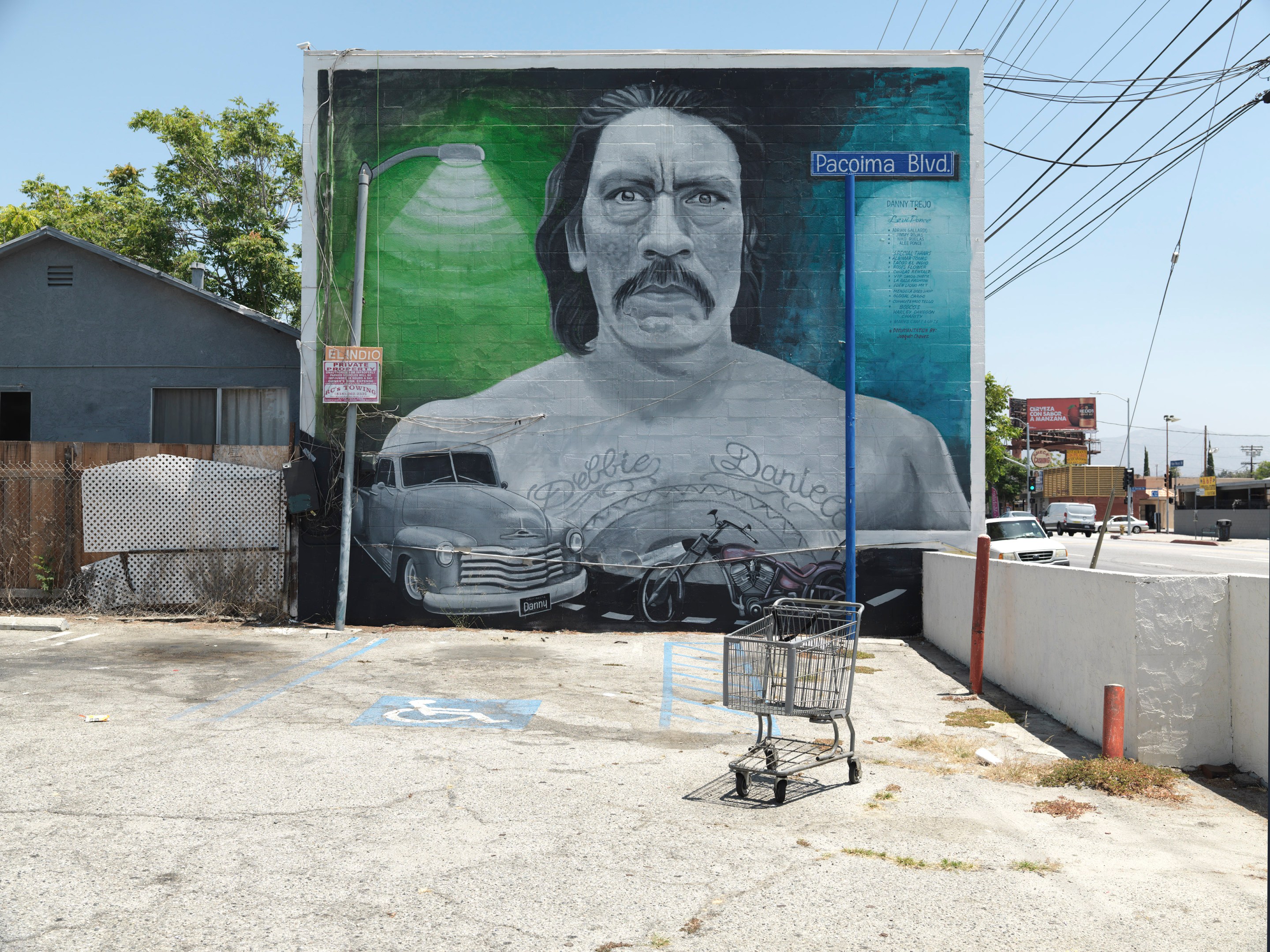[dropcap size=big]P[/dropcap]art of the Getty-led Pacific Standard Time: LA/LA, this fascinating and timely exhibition explores the historical and contemporary impact of murals in Los Angeles, featuring more than 140 photographs by the artist. Both a meditation on the nature of public art and signage and how it impacts the city of Los Angeles, the show is also a current-day documentation of the city's current street scene, including images of work by leading muralists like Levi Ponce and Kent Twitchell alongside graffiti artists like the LOVE Crew.
There's an element of interactivity as well-- a digital map and a large map on the gallery floor will allow visitors see the murals in their geographical context, and to trace Gonzales-Day’s route through Los Angeles as he documents the city's public art. Visitors can also take home a printed map of the city that shows the location of each mural in the show and invites them to document their own finds as well.
Keep reading for a preview of some of the images that will be on display, along with all the information you need about the show from the Skirball Cultural Center.
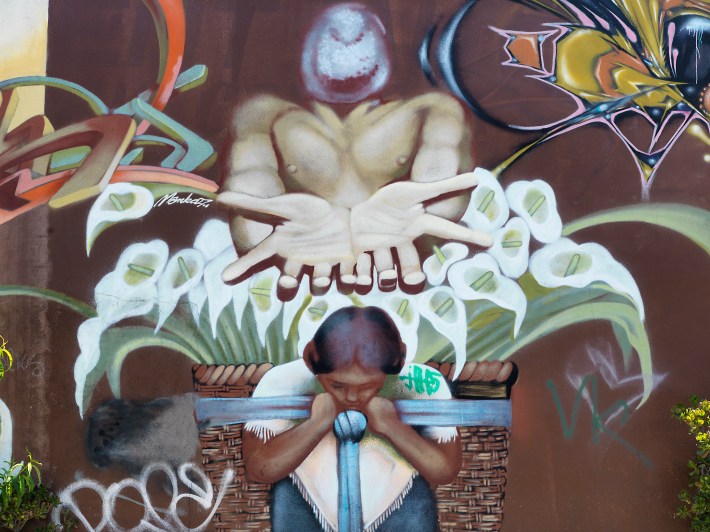

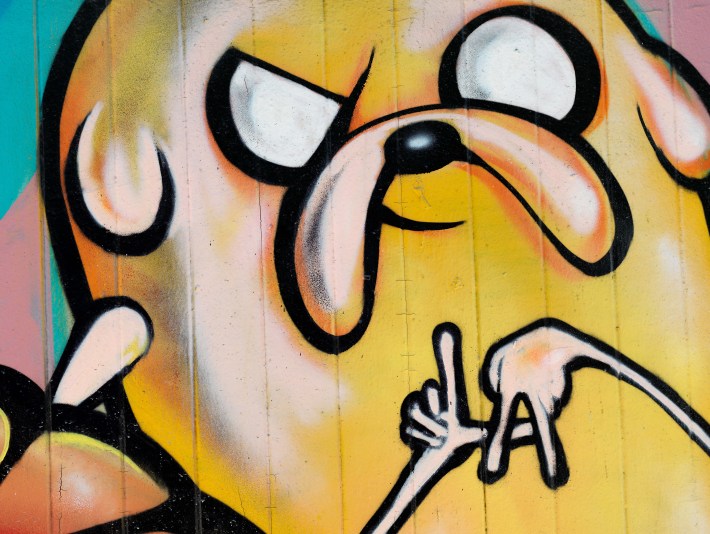
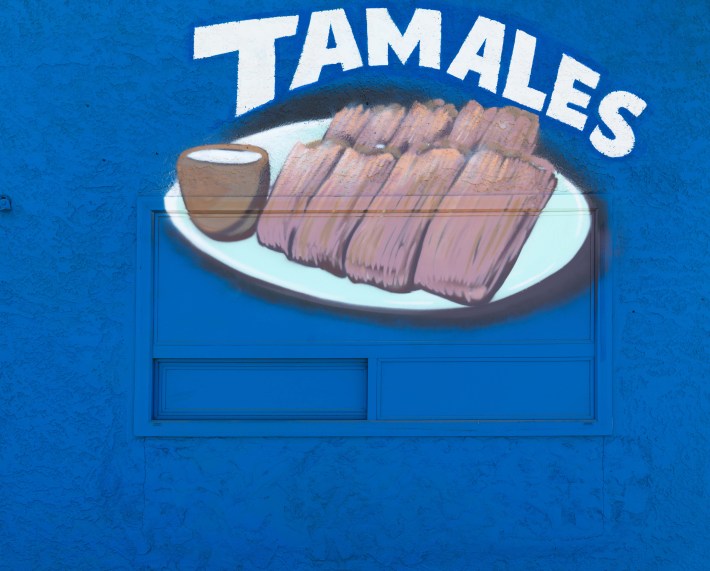
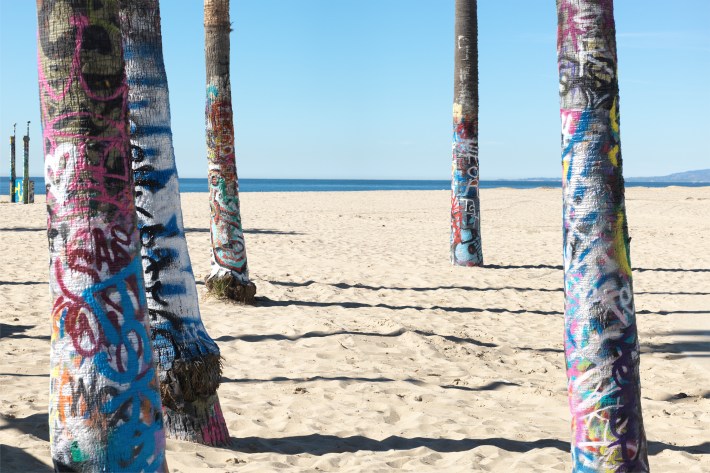
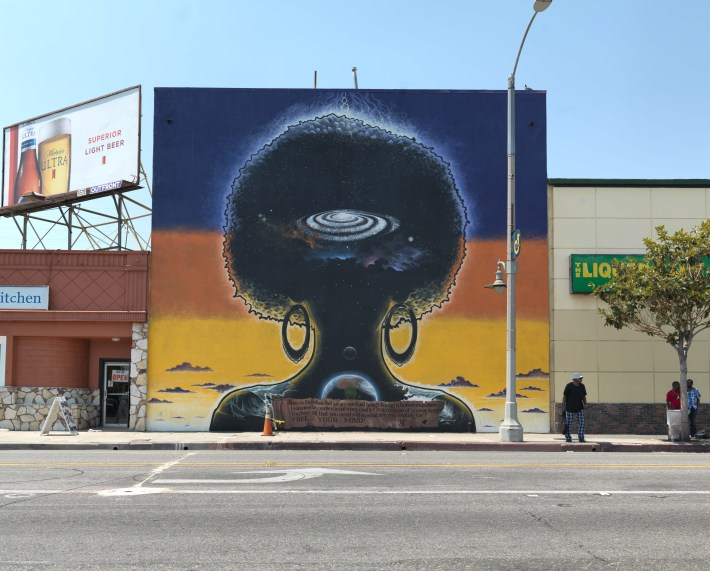
Patrick Henry Johnson, Crenshaw Blvd at Stocker St, Leimert Park, 2011. © 2017 Ken Gonzales-Day.
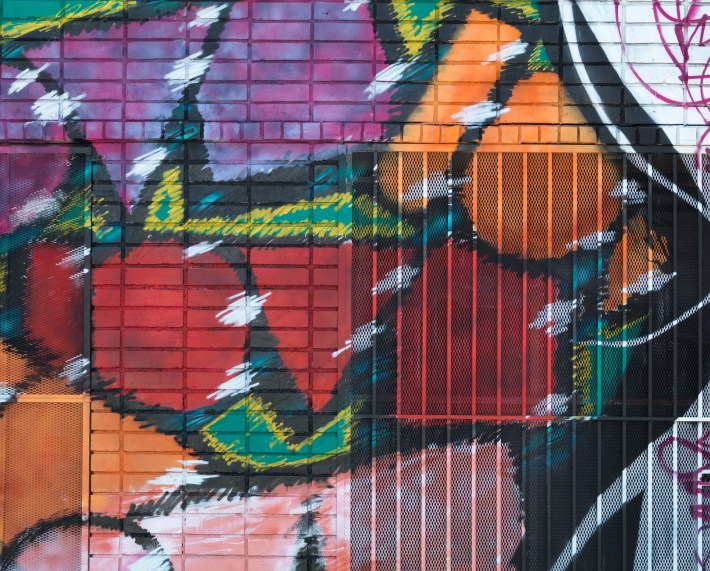
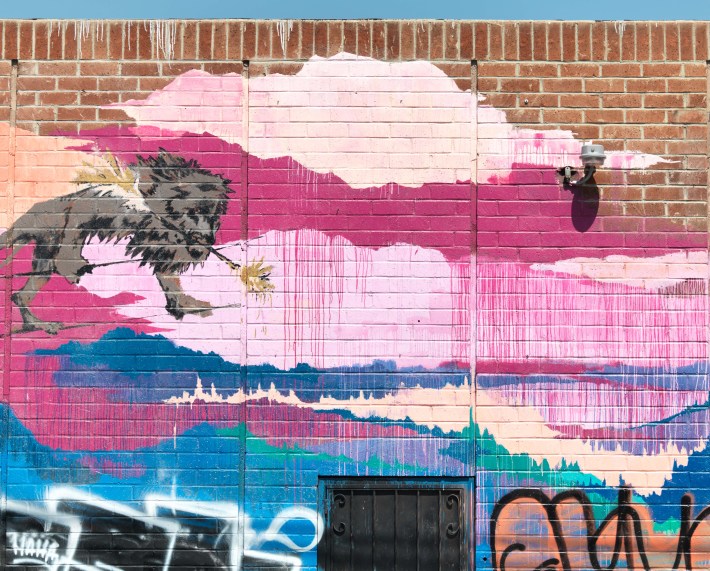
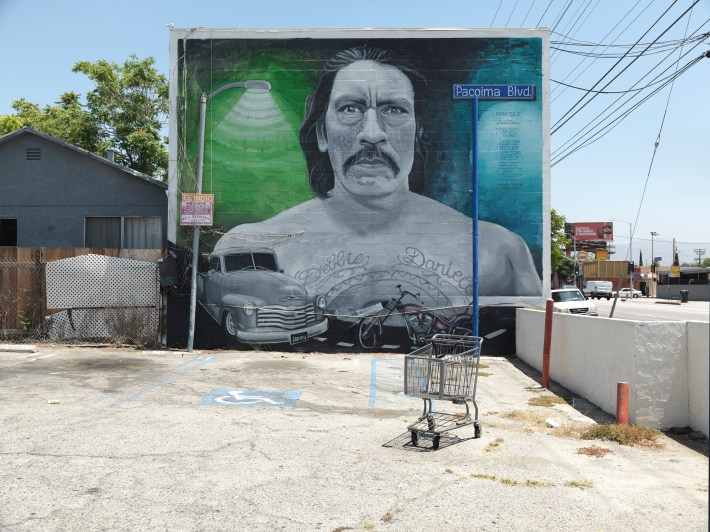
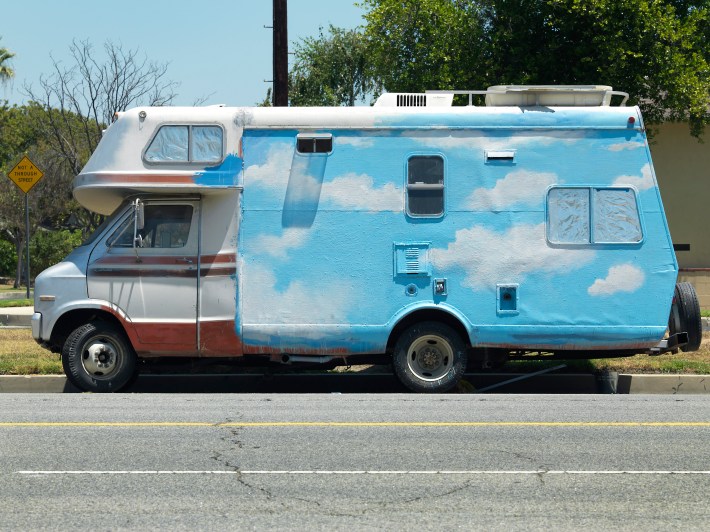
The Skirball Cultural Center announces Surface Tension by Ken Gonzales-Day: Murals, Signs, and Mark-Making in LA, on view October 6, 2017 through February 25, 2018. This exhibition features more than 140 new photographs by Ken Gonzales-Day that capture the vibrant face of muralism and related practices, such as street art, graffiti writing, and sign painting, throughout the city of Los Angeles. An interdisciplinary artist whose practice considers race and representation, Gonzales-Day examines Los Angeles’s rich tradition of muralism—from the celebrated to the humble, the historic to the contemporary— and illustrates how murals invite participation from artists of all backgrounds, portray the experiences of diverse communities, and define the visual landscape of Los Angeles’s streets.
In a city characterized by an expansive sprawl of diverse neighborhoods easily bypassed via freeways, the exhibition encourages visitors to examine their surroundings, venture off familiar paths, and encounter new communities. “I believe these images reveal more about Los Angeles and its communities, its struggles, and its losses than one can find in any book,” Gonzales-Day remarked.
Developed collaboratively between Gonzales-Day and Skirball curators, the project set the artist on a ten- month journey across the city—from East Los Angeles to Venice Beach, from Pacoima to Watts. As he traversed hundreds of miles, Gonzales-Day photographed the murals he encountered, and explored cultural influences such as graffiti writing, street art, sign painting, film, music, television, and commercial advertising. His works document contributions by numerous prominent muralists, including Kent Twitchell and Levi Ponce, as well as artists who remain anonymous but no less important to the aesthetics of the city.
Surface Tension by Ken Gonzales-Day is inspired by the city’s dynamic history of muralism, which has strong roots in the Mexican Renaissance of the 1920s. During that period, Mexican muralists Diego Rivera, José Clemente Orozco, and David Alfaro Siqueiros came to paint in the United States. The exhibition situates contemporary artists within this larger history of muralism, considering how Rivera, Orozco, Siqueiros, and others inspired generations of artists to take their brushes, rollers, and aerosol cans to the walls of Los Angeles.
Since roughly the 1930s, muralists have chronicled important chapters in Los Angeles’s history, such as the Chicano movement of the 1960s and 1970s, the 1984 Olympics, and the ongoing importance of the Hollywood film industry. As captured by Gonzales-Day, these public works also comment upon shifting representations of race in the city and the role they play in the politics of space. Although a decade-long ban on mural-making temporarily stifled the form until 2011, the practice has enjoyed renewed vitality in the past decade amid the redevelopment of downtown Los Angeles and the rise of street art as a prominent and respected medium.
“Ken Gonzales-Day’s sensitive and dynamic photographs demonstrate how murals tell stories of Los Angeles communities and individuals. Accessible to everyone and often stumbled upon accidentally, murals reveal how art often stimulates conversation, bridges divides between people, and creates understanding,” said Robert Kirschner, Skirball Museum Director. “The sense of invitation inherent in these public works and the ways they foster human connection are central to the Skirball’s mission.”
Surface Tension by Ken Gonzales-Day moves from neighborhood to neighborhood, reflecting the unique concerns, aesthetics, and history of each area. A grouping of photographs highlights recurring themes that stuck with Gonzales-Day as he drove: reflections on the politics of space and belonging; the representation of cultural heritage; the cult of celebrity; and the very question of what counts as a mural and who gets to decide.
The exhibition will also feature gallery interactives designed to encourage visitors to embark on their own journeys. Both a digital map and a large map on the gallery floor will enable visitors to consider the geographic relationships between the murals and to trace Gonzales-Day’s route through Los Angeles. Visitors will be able to take home a printed map of the city that pinpoints the location of each mural on view, and invites them to document their own discoveries.
Surface Tension by Ken Gonzales-Day complements the Skirball’s major fall/winter exhibition, Another Promised Land: Anita Brenner’s Mexico. Both are part of Pacific Standard Time: LA/LA, a far-reaching and ambitious exploration of Latin American and Latino art in dialogue with Los Angeles, taking place from September 2017 through January 2018 at more than seventy cultural institutions across Southern California. Pacific Standard Time is an initiative of the Getty.
ABOUT THE ARTIST
Ken Gonzales-Day is a Los Angeles–based photographer, interdisciplinary artist, and 2017 Guggenheim Fellow. His series Searching for California Hang Trees offered a critical look at the lack of documentation of lynching sites in California, while his series Erased Lynching sought to address the larger erasure of Asians, African Americans, Latinos, and Native Americans from the history of lynching in California and beyond. The Profiled series reached even further back into history to consider how the sculptural depiction of race, and its display, contributed to racial formation today. His work has been widely exhibited nationally and internationally at LACMA, LAXART, the Tamayo Museum in Mexico City, the New Museum in New York City, and the Palais de Tokyo in Paris; and he has been commissioned by LA Metro for several public artworks around Los Angeles. He was a key organizer for the Pacific Standard Time: LA/LA Place and Practice symposium in San Diego and Los Angeles in May 2015. Gonzales-Day holds a MFA in studio art from University of California, Irvine; a MA in art history from City University of New York; and BFA in painting from Pratt Institute. He is a professor of art at Scripps College, where he teaches photography and related art courses.
ABOUT ANOTHER PROMISED LAND: ANITA BRENNER’S MEXICO
Another Promised Land: Anita Brenner’s Mexico, on view September 14, 2017–February 25, 2018, illuminates the life and work of one of the most fascinating cultural figures of twentieth-century Mexico, Anita Brenner (1905–1974). A Mexican-born journalist, art historian, and anthropologist of Latvian Jewish descent who spent part of her youth in Texas, Brenner chronicled the Mexican Renaissance of the 1920s and played a vital role in introducing Mexican art and culture to American audiences. Through more than 150 objects—including artworks by close friends Diego Rivera, José Clemente Orozco, Edward Weston, Jean Charlot, and Frida Kahlo―the exhibition underscores her efforts to build cultural understanding between the United States and Mexico.
SURFACE TENSION BY KEN GONZALES-DAY: MURALS, SIGNS, AND MARK-MAKING IN LA IS ORGANIZED BY THE SKIRBALL CULTURAL CENTER AS PART OF PACIFIC STANDARD TIME: LA/LA.
GENEROUS SUPPORT FOR THE EXHIBITION AND ITS RELATED EDUCATIONAL PROGRAMS IS PROVIDED BY THE FOLLOWING DONORS:
Photographic Arts Council · Los Angeles Pasadena Art Alliance
Sauvage Family
Specialty Family Foundation
US Bank
ADDITIONAL SUPPORT IS PROVIDED BY:
The Dubois Family Charitable Fund Good Works Foundation
Carol Vernon and Bob Turbin
About the Skirball Cultural Center
The Skirball Cultural Center is a place of meeting guided by the Jewish tradition of welcoming the stranger and inspired by the American democratic ideals of freedom and equality. We welcome people of all communities and generations to participate in cultural experiences that celebrate discovery and hope, foster human connections, and call upon us to help build a more just society.
Visiting the Skirball Cultural Center
The Skirball Cultural Center is located at 2701 N. Sepulveda Blvd., Los Angeles, CA 90049. Museum hours: Tuesday– Friday 12:00–5:00 p.m.; Saturday–Sunday 10:00 a.m.–5:00 p.m.; closed Mondays and holidays. Admission to exhibitions is $12 General; $9 Seniors, Full-Time Students, and Children over 12; and $7 Children 2–12. Exhibitions are always FREE to Skirball Members and Children under 2. Exhibitions are FREE to all visitors on Thursdays. For general information, the public may call (310) 440-4500 or visit skirball.org.
About Pacific Standard Time: LA/LA
Pacific Standard Time: LA/LA is a far-reaching and ambitious exploration of Latin American and Latino art in dialogue with Los Angeles taking place from September 2017 through January 2018. Led by the Getty, Pacific Standard Time: LA/LA is a collaboration of arts institutions across Southern California.
Through a series of thematically linked exhibitions and programs, Pacific Standard Time: LA/LA highlights different aspects of Latin American and Latino art from the ancient world to the present day. With topics such as luxury arts in the pre-Columbian Americas, twentieth century Afro-Brazilian art, alternative spaces in Mexico City, and boundary-crossing practices of Latino artists, exhibitions range from monographic studies of individual artists to broad surveys that cut across numerous countries.
Supported by more than $16 million in grants from the Getty Foundation, Pacific Standard Time: LA/LA involves more than seventy cultural institutions from Los Angeles to Palm Springs, and from San Diego to Santa Barbara. Pacific Standard Time is an initiative of the Getty. The presenting sponsor is Bank of America.
